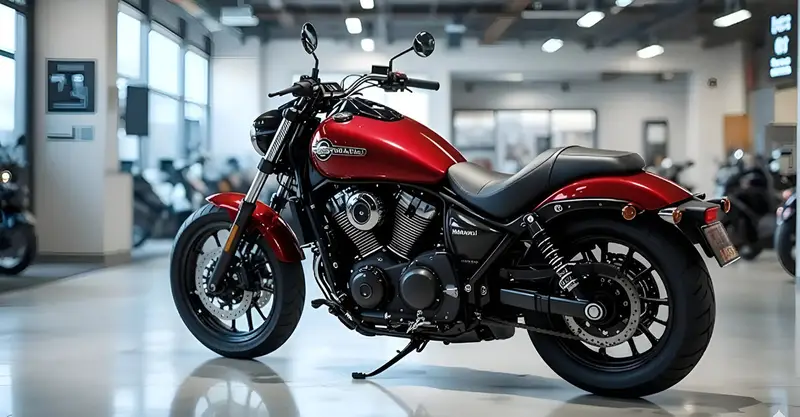The Kawasaki Vulcan 2000 is that legendary power cruiser from the early 2000s that redefined big V-twin performance with its massive 2,053cc engine and bold styling, making it a cult favorite for riders who crave raw torque and highway dominance. Discontinued in 2010 after six years of production, it’s a used-market gem today, with prices ranging from $8,000 to $15,000 depending on condition and mileage, appealing to cruiser enthusiasts, custom builders, and Harley rivals on a budget. It competed with the Honda VTX1800, Yamaha Road Star, and early Harley Touring models, offering 116 hp, 141 lb-ft of torque, and a fuel-injected setup for effortless 0-60 mph in under 5 seconds. This review dives into its specs, features, and why it’s still a beast worth hunting.
Rugged and Relaxed Design
The Vulcan 2000 nails the classic cruiser look with a low-slung frame, wide fenders, and a sculpted tank that commands attention. It’s a heavyweight at 760 lbs (wet), measuring 100.8 inches long, 36.6 inches wide, and 43.9 inches high, with a 67.3-inch wheelbase for stable cruising. With 5.1 inches of ground clearance, it hugs pavement but handles minor bumps, shod in tubeless tires on 17-inch front and 16-inch rear cast wheels (130/90 front, 200/60 rear). Available in colors like Ebony, Candy Plasma Blue, and Pearl Flat Stardust White, it features a solo seat at 26.8 inches height—saddlebags and a 5-gallon tank make it ready for long hauls, radiating timeless power cruiser dominance.

Clear Display
The analog-digital instrument cluster is straightforward, showing speed, tach, fuel, and gear position with basic trip data. No Bluetooth or touchscreen in its era, but aftermarket upgrades can add nav. Handlebar switches are intuitive for lights and horn—it’s no-fuss, perfect for keeping eyes on the road during relaxed cruises, though the small LCD feels dated today.
Punchy Performance
Powered by a 2,053cc liquid-cooled 52-degree V-twin SOHC engine (116 hp at 4,800 rpm, 141 lb-ft at 3,200 rpm), it mates with a 5-speed manual and belt drive for smooth shifts. Fuel-injected for reliability, it claims 35-40 mpg (15-17 km/l)—real-world 30-35 mpg in mixed riding, with a top speed of 120 mph and 0-60 mph in under 5 seconds. The 5-gallon tank stretches 150-175 miles, and telescopic front forks with progressive rear shock deliver a plush ride—torquey for effortless cruising but composed in corners, ideal for highways or city jaunts.
Advanced Safety System
Dual-channel ABS was optional on later models with 11.8-inch front and 11.5-inch rear discs for confident stops—no traction control, but the steel tube frame adds stability. Halogen taillight boosts visibility, and the side-stand engine cut-off provides basics—handles wet roads or swerves well for its era, making it forgiving for cruiser riders.
Long-Lasting Fuel System
The 5-gallon tank covers 150-175 miles for 1-2 days of cruising, refills under 2 minutes. Economy at $2.50-3 per gallon, low vibes for quiet rides—liquid cooling keeps it cool without fatigue.
Connectivity and Features
Halogen headlamp lights the way, with optional cruise control and heated grips—no Bluetooth standard, but aftermarket kits add it. The belt drive smooths power delivery, with a comfortable seat for long rides—no full audio, but earbuds pair for tunes. Extras like saddlebags keep it practical, loaded just enough without fluff.
Pricing and Availability
Used prices range from $8,000 for base models to $15,000 for low-mileage VR-4 equivalents (MSRP equivalent). Discontinued in 2010, available via used markets like Cycle Trader or eBay. Maintenance $400-600/year, no warranty on used. Availability: Rare, wait times vary.
User Feedback and Drawbacks
Owners love the torque surge, chrome bling, and highway stability—the 5.1 inches clearance suits smooth roads, and V-twin rumble is addictive. Belt drive and comfort get props. But 760 lbs weight’s tough in traffic, low clearance scrapes bumps, and mileage dips loaded—parts scarcity and servicing pricey for big V-twins.
Comparison with Competitors
In the $8,000-$15,000 used cruiser bracket, the Vulcan 2000 out-torques the VTX1800 but trails the Road Star in retro charm. Matches the Touring’s luxury, Kawasaki’s reliability edges for hauls.
Speculative Notes
Discontinued 2010, used $8,000-$15,000, 2,053cc V-twin, 30-35 mpg. No 2025 revival; check used markets.
Final Thoughts
The Kawasaki Vulcan 2000, with its 100.8-inch frame, thumping 2,053cc V-twin, and cruiser soul at $8,000-$15,000 used, is the power cruiser that defined early 2000s muscle. It’s not light or modern, but torque, presence, and Kawasaki legacy make it a cult classic. With aftermarket support, it’s ready to rumble.